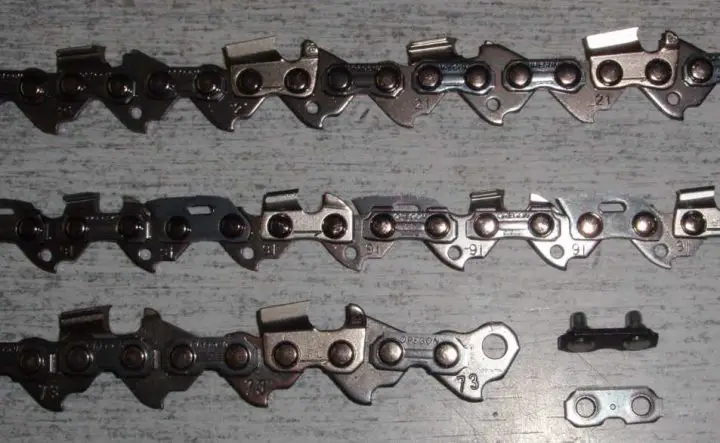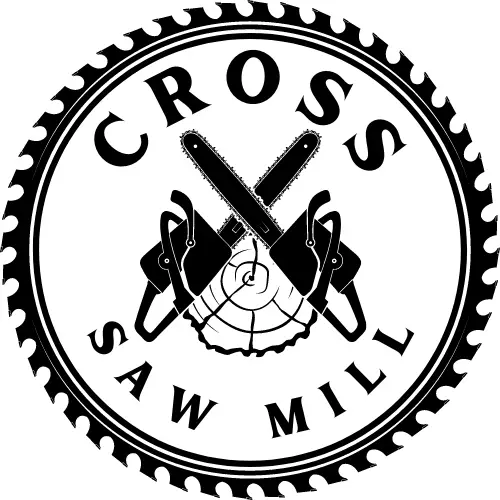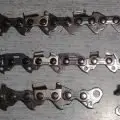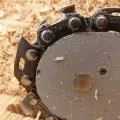Do you believe that your chainsaw isn’t cutting through wood as well as it used to 4-5 sessions ago? This is due to the fact that a chainsaw loses its edge after a few uses and needs to be sharpened again. But how many times can a chainsaw chain can be re-sharpened? The simple answer is that it depends on the kind of wood you’re cutting and how often you do it. In this article, we’ll discuss a chainsaw chain’s life expectancy, how many times you can sharpen it, what steps you can take to keep it sharp for longer, and more.
Table of Contents
- How Long Do Chainsaw Chains Last?
- How Many Times Can You Sharpen a Chainsaw Chain Before It Needs Replacing?
- What Can Dull My Chainsaw Chain?
- Signs That My Chainsaw Chain is Sharp
- Signs That It Is Time to Replace Your Chainsaw Chain
- How to Replace Chainsaw Chains
- Top Tricks to Maintaining a Sharp Chainsaw Chain
- How to Maximize Chainsaw Chain Lifespan
- A Reminder!
- FAQs (Frequently Asked Questions)

How Long Do Chainsaw Chains Last?
Generally, with regular use and proper maintenance, a chainsaw chain can last anywhere from 5 to more than 20 hours of cutting time before it needs to be sharpened.
The lifespan of a chainsaw chain can vary widely based on several factors, including the quality of the chain, the type of material being cut, how frequently the chainsaw is used, and how well the chain is maintained.
Chainsaw Chain Life Expectancy
A single chainsaw chain can be used properly for several hours under typical conditions. As unbelievable as it may seem, this is the case.
The chain’s cutters are simply single steel chainsaw blades that resemble knives. How frequently should kitchen knives be replaced, especially those that aren’t used frequently? Roughly every ten years?
However, how you use your chainsaw will also affect how long it lasts. The chainsaw’s level of maintenance and frequency of use will be important considerations.
The crucial query is now: How many times can a chainsaw chain be sharpened before it needs replacing?
How Many Times Can You Sharpen a Chainsaw Chain Before It Needs Replacing?
A chainsaw chain can typically be sharpened 12–15 times before it needs to be replaced. This frequency ensures that the chain maintains optimal cutting efficiency and minimizes potential kickback issues.
The longevity of a chainsaw chain, however, also depends on the frequency and manner of use. With frequent use, a chain might need replacement before five years, but with moderate use, it can last a decade or more.
Proper sharpening technique, as outlined in the user manual, including the correct angle and file diameter, is crucial to extending the life of the chain.
Different users and their various chainsaw usage techniques provide various results. As a general rule, the chainsaw chain should be sharpened after the second or third fuel refill. To keep the chain in top shape, make sure you sharpen it as soon as it becomes dull.
Additionally, you must avoid bumping into any pebbles or dirt because doing so can dull your chainsaw blade. Having said that, a chainsaw chain may be easily sharpened 12–15 times. Your chain will stop working correctly after that, and you’ll need to buy a new one.
If you use chainsaws frequently, you shouldn’t be concerned about replacing the chain before at least five years. Your chainsaw chain can easily last a decade or more if your use of the chainsaw is moderately limited. The performance of the chainsaw will be enhanced by sharpening the chain, and potential kickback problems will also be avoided.
The next step is to consult the user manual and determine the proper sharpening angle and file diameter. Use the rounded one with a diameter of 4-6 mm as a general rule. Start filing from the inside edge of the chainsaw chain to the outside portion.
When using a file, never rotate it while using it, and take care not to damage the tooth. While sharpening them with the chainsaw sharpener, you wouldn’t want to press them upward or downward. Each tooth should be filed until it has the same size and appearance.
Even though it doesn’t need to be done as often as the cutters, the depth gauge should be filed. To prevent potential file damage, file the gauge teeth flat. The direction in which you should perform this is the same as the chain cutters. Your chainsaw chain will last for many years if you follow these suggestions.
Learn all about this and more in our Chainsaw Chain File Sizes Chart & How to Sharpen a Chainsaw Chain guides!
What Can Dull My Chainsaw Chain?
Several factors can contribute to the dulling of your chainsaw chain, impacting its efficiency and requiring more frequent sharpening or replacement.
- Cutting Dirty or Sandy Wood: Dirt, sand, and mud on the wood can act as an abrasive on the chain, quickly dulling its teeth.
- Hitting the Ground: Accidentally touching the ground with the chainsaw while cutting can instantly dull the chain because soil and rocks are much harder than wood fibers.
- Contact with Metal, Nails, or Other Foreign Objects: Cutting into materials that chainsaws aren’t designed to cut, such as metal or nails embedded in trees, can blunt the chain’s teeth.
- Improper Sharpening Techniques: Incorrectly sharpening the chain, such as using the wrong file size or sharpening at an incorrect angle, can lead to uneven wear and dullness.
- Using the Chainsaw on Hardwood Continuously: Hardwoods are denser and place more stress on the chain than softer woods, leading to faster dulling.
- Lack of Lubrication: Insufficient chain oil reduces the chain’s efficiency and increases friction, causing the chain to dull more quickly.
- Incorrect Chain Tension: A chain that’s too tight or too loose can increase wear and tear, leading to premature dulling.
- Wear and Tear Over Time: Normal use will gradually dull the chain, even if all the proper precautions are taken and the chainsaw is used on clean, appropriate materials.
Signs That My Chainsaw Chain is Sharp
Sharp chains are preferable for chainsaws since they maximize the cutting potential. Knowing if the chain is sharp or dull will aid with chainsaw bar maintenance, thus it is crucial to know.
As all chains progressively lose their sharpness over time, it will assist you in making sure the chainsaw is functioning properly. Additionally, this will make it simpler to reduce and regulate chainsaw kickback, which is the primary cause of accidents involving chainsaws.
Here are some signs that will let you know your chainsaw chain is sharp and in prime working condition.
Thick Sawdust Production
A chainsaw chain’s sharpness can be determined by the amount of sawdust it produces while cutting trees, wood, or logs. The chainsaw needs to produce thick sawdust, resembling coarse strands when cutting wood vertically.
On the other hand, a worn-out chain will produce fine sawdust. Compared to what sharp chains generate, this will be thinner. The chain is undoubtedly dull and worn out if the sawdust is smooth and has a finer texture.
Ease of Cut
If the chain on your chainsaw is sharp, the chainsaw won’t sway as you cut it left or right. It will be more difficult to place and cut through if it is worn out. Cutting the trees won’t be simple, and you’ll find that even with the motor running, the machine keeps getting stuck. This is among the simplest methods for determining if the chain on your chainsaw is sharp or not.
You don’t need to exert any internal or external force to cut when using a chainsaw. You evidently have a worn-out and dull chain if you feel the need to exert additional strain. Therefore, cutting through the wood has grown more challenging.
A sharp chain, on the other hand, would need little to no pressure to cut through the wood. Such circumstances are particularly beneficial since you can quickly determine if the chainsaw chain is sharp or not.
Signs That It Is Time to Replace Your Chainsaw Chain
A dull chainsaw will compromise not just its functionality but also your safety. The chain can be sharpened a few times, but eventually, you’ll need to replace it with a new chain. Here are some signs that your chainsaw chain needs to be replaced because it is too dull.
Rusty or Damaged Chain
Any use of a corroded chain should be avoided. This will reduce the chainsaw’s effectiveness and harm the teeth and blades.
Chainsaw chains should be replaced if they become damaged or chipped due to impact with pebbles or soil, incorrect sharpening, or other factors. In fact, one of the most frequent causes of subsequent chainsaw damage is failure to replace the chainsaws following this. Additionally, it is a sign that the chain has to be replaced if the highest points of the chain are missing.
If You’re Unable to Get Desired Cuts
When you are trying to cut and you are unable to achieve the desired cuts, you will instantly realize it’s because of a too-blunt chain. Additionally, if your chain starts to clatter and rattle, there can be a problem with the chain.
Maxed Out Safety Lines
The majority of chainsaw models have tiny lines that show the maximum amount of metal that can be removed. Safety lines are what these lines are called.
Every time you use a file to sharpen your chainsaw chain, you are filing away the metal and getting closer to the safety lines. You won’t be able to sharpen the chain after you cross this line, and you won’t be able to use it again.
How to Replace Chainsaw Chains
Here’s a step-by-step guide on how to replace the chainsaw chain (depending on the brand, this might change):
- Gather Necessary Tools: You may need a wrench or a screwdriver to remove the guide bar side panel.
- Ensure Safety: Make sure the chainsaw is turned off and the spark plug is disconnected to prevent accidental starts.
- Release Chain Tension: Locate the chain tensioning screw, which is usually positioned on the side of the chainsaw near the guide bar. Loosen this screw to release the tension on the chain.
- Remove the Side Panel: Use your wrench or screwdriver to remove the nuts or screws holding the side panel in place. Carefully remove the side panel to access the chain.
- Remove the Old Chain: Lift the guide bar away from the chainsaw to slacken the chain, making it easier to remove. Slide the chain off the bar, starting from the top, and pull it away from the drive sprocket.
- Clean the Chainsaw: Before installing the new chain, take the opportunity to clean any debris from the chainsaw, particularly around the drive sprocket and guide bar.
- Install the New Chain: Ensure the new chain’s cutting teeth are facing forward on the top of the guide bar. Loop the chain over the drive sprocket and along the guide bar, ensuring it sits in the guide bar’s groove all around.
- Reattach the Side Panel and Adjust Tension: Replace the side panel and loosely tighten the nuts or screws. Before fully tightening, adjust the chain tensioning screw to make the chain snug but not too tight. The chain should move freely around the bar but not hang loose.
- Final Tightening: Once the chain tension is correctly adjusted, fully tighten the nuts or screws on the side panel.
- Perform a Safety Check: After replacing the chain, check the chainsaw’s safety features, such as the chain brake, to ensure they are functioning correctly.
- Test the Chainsaw: Reconnect the spark plug and start the chainsaw to test the new chain for proper operation. Ensure the chain moves smoothly and that there are no issues with tension or alignment.
Top Tricks to Maintaining a Sharp Chainsaw Chain
You should take a few factors into account if you want to increase the lifespan of your chainsaw chain. You can maintain the chainsaw chain in top functioning condition by following these instructions. There are a few maintenance suggestions that you should keep in mind in addition to the guidelines provided by the user manual.
Clean the Dirt and Debris Off the Chain
After each use, take off the chainsaw’s cover and begin scrubbing the chain with a piece of metal or wood. Remove all dirt and debris from the track’s interior. After that, take off and clean the cylinder cover’s air intake and cooling fans.
Clean the air filter as well as any dirt that has gotten lodged in the confined places. Check the flywheel fins to make sure nothing is preventing air from entering the motor.
Store Your Chainsaw Indoors
Keep your chainsaw inside if possible. Any building will do, including a barn, a shed, or even a garage. Avoid leaving your chainsaw outside where it can be harmed by the weather or other elements.
Place the Chainsaw in a Scabbard
After using it, you should sheath the chainsaw before putting it away. This will shield the device from scratches, dings, and bumps. You’ll also be protected from taking inadvertent cuts as a result of it.
Keep Checking the Bar and Chain Oil
Every time it is used, the chainsaw bar and chain oil levels need to be checked. The chain and bar need to be carefully oiled after the debris has been removed and the parts have been put together. Chain oil would be the most effective way to accomplish this. Then let the engine run for a short while.
Nowadays, the majority of chainsaws have built-in technologies that enable the lubricant to automatically draw oil as the chain spins.
How to Maximize Chainsaw Chain Lifespan
- Keep it sharp: Regularly check and sharpen your chain to ensure efficient cutting and reduce stress on the chainsaw.
- Lubricate the chain: Ensure the chainsaw’s automatic oiler is working correctly, and use the right type of chain oil.
- Clean after use: Clean any debris from the chain and bar to prevent buildup that can lead to premature wear.
- Careful where you cut: Avoid cutting close to the ground or in areas where foreign objects like nails might be present.
- Store properly: When not in use, store the chainsaw in a dry, clean place to prevent rust and corrosion.
- Proper tension: Maintain proper chain tension according to the manufacturer’s specifications.
A Reminder!
Don’t forget to put on safety gear when using a chainsaw, such as eye protection, gloves, steel-toed shoes, and ear protection. Another thing to remember is to shut off the cabin and stabilize it on a firm surface.
Hope I was able to answer your questions about a chain’s longevity!
FAQs (Frequently Asked Questions)
How many times can I sharpen a chainsaw chain?
A chainsaw chain may be easily sharpened 12–15 times. After that, your chain will no longer function properly, and you will need to purchase a new one.
How long should a sharpened chainsaw last?
The chainsaw chain can survive for more than five years if you use it every day. If it is properly maintained, it can last for decades even if you are a casual user. It’s because the chainsaw has teeth, which are blades that are eaten with each usage and eventually grow dull.
Why does my chainsaw chain dull so quickly?
When you’re sawing through logs, if your angle of approach is too steep, a simple cut-through could nick dirt or, worse, pebbles on the floor, which would cause your chainsaw to jerk and dull a lot quicker than normal. They could damage other components of the chainsaw, such as the chain links, in addition to quickly dulling your chains.




